
Permanent pool sealing (existing construction) with Penetron's endochemical action and crystal growth system or using conventional Sealcoat Systems
INTRODUCTION:
Existing concrete swimming pools, are called those, that are fully constructed with landscaped garden or surrounding surfaces (covered with tile, wood, marble, etc.) or bordering with other concrete constructions, such as building, basements, garages, tunnels, etc. Also, there are incomplete pools with existing concrete walls, or, in some cases, with ementitious screed layer, but without a finished surface (tiles, paint, etc.).
I. Waterproofing of a swimming pool with a finished surface of the concrete surface.
1. Repair of concrete nests from non-woven parts, as well as sealing of "morels" and "hairpins" with PENETRON® penetrating penetrant and the repair agent of corresponding technology PENECRETE MORTAR and repair of cracks with running water with the fast-setting mortar with PENEPLUG® crystal growth.
Initially, depending on the planning of the progress of the work, we can clean and process the surface of the concrete with high pressure water jetting (300 – 500 bar), so that we can have a better "picture" of the individual problems. Penetron
Next, we treat water inflow from cracks with PENEPLUG® active crystal growth quick-setting mortar, (mixed with minimal water, loam form). For the application of PENEPLUG®, we should widen the cracks with a digging tool to a width of 2-3 cm and with a conical base on the inside, for better anchoring of the fast gel during its application. We deal with the stop joints in the same way, cutting on both sides with a cutting wheel and then creating a conical "gutter", about 3 cm wide, using a digging tool. Then, we apply the PENEPLUG® fast-setting mortar. Penetron
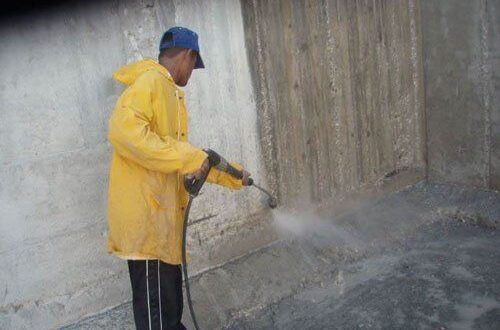
In some cases, depending on the design of the works, we can apply PENEPLUG® first, so as to limit the inflow of water and then the treatment with water jetting, since PENEPLUG® has acquired good mechanical resistance. It must be clarified that after the PENEPLUG® has been pulled (still fresh), 1 – 2 layers of PENETRON® aqueous chemical action and crystal growth mixture should be applied, in a mixing ratio of 5 parts PENETRON® powder to 3 – 3 .5 parts of water (by volume), for easy application with a brush, and a total consumption for both layers of approximately 1.5 kg/m2. Penetron
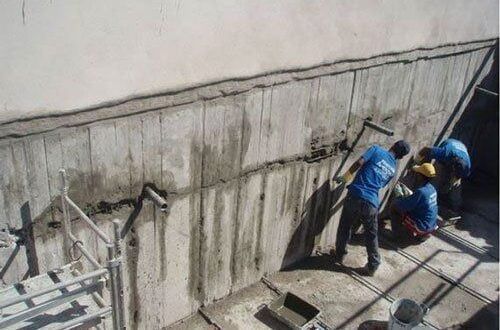
By mechanical means we widen the holes and nests that have resulted from concreting. Also, by mechanical means we widen the area around the "hairpins" to a width of at least 35 mm and a depth of 20-30 mm. Then we cut the "hairpin" with a wheel about 20 mm in. The "morels" are required to be completely removed or at least cut, creating a 30 x 30 x 40mm reverse wedge recess. We rinse the holes with plenty of water, on the one hand to remove the generated solids, on the other hand to saturate the area with water, which is a necessary condition for the operation of the penetrating, penetrating, sealing material with chemical action and crystal growth PENETRON ® and the same technology repair PENECRETE MORTAR. On a surface that is wet and without water pools, apply an aqueous mixture of PENETRON® sealing material, in a mixing ratio of 5 parts PENETRON® powder to 3.5 parts water (by volume), only in the area of the holes and nests and 1 cm around them . While the PENETRON® sealant is still fresh, mix PENECRETE MORTAR powder with enough water to achieve the desired plasticine texture [usual mixing ratio is 4.5 parts PENECRETE MORTAR with 1 part of water (by volume)] and fill the holes and nests of the poor concreting. As soon as the repair mortar PENECRETE MORTAR has set, but is still wet, a second, only local, application with an aqueous mixture of PENETRON® follows. Penetron
2. Application of Penetron® integral capillary waterproofing system.
It is possible to either apply PENETRON® water-based coating, penetrating, sealing material with chemical action and crystal development only to the inner surface of the pool, or to the outer surface as well (after excavating the surrounding surface). Alternatively, on the external surface it is possible to apply the SEALCOAT FLEX system (22.68 kg PENETRON® SEALCOAT in a solution with 4 kg PENECRYL ELASTIC and 3 kg water), reinforced with mesh or without, or the application of the elastomeric polyurethane membrane, two components, PENECOAT™ HYPER ELASTIC BLACK, by roller, brush or notched trowel, on the properly primed and prepared surface. Penetron
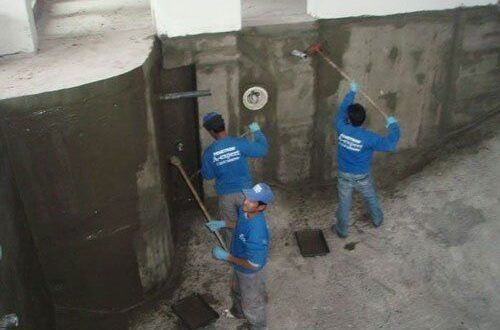
According to general directives for cement curing, PENETRON® SYSTEM should cure for 10-12 days, prior to water exposure.
3. Neutralization
Because the application of PENETRON® products on the concrete surface causes the formation and appearance of silicates, not only inside the concrete, but most of the time also on the application surface (usually after the first 48 hours), you create a technical issue with the reduction the adhesion of decorative coatings or paints. The problem is dealt with by the process called "neutralization". Neutralization is essentially a "washing" of the surface after about 3 weeks (safe time of PENETRON® system operation) with a low "aggressive" acid, such as a 3-8% hydrochloric acid (HCl) solution or a vinegar solution with water (in a ratio of 1:1 to 1:3, depending on acidity). Penetron
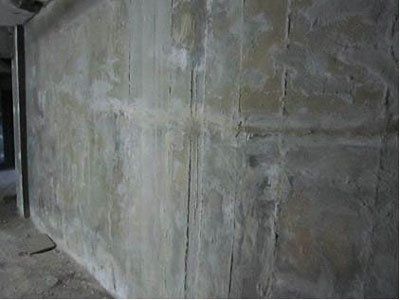
During application, after cleaning the surface with a broom, using a brush and a plastic container containing the neutralization liquid, we "wash" the surface and then, after a few minutes, rinse with plenty of clean water. The surface can then, after drying, be plastered or painted. Penetron. Alternatively, in the case of coatings or coating mortars, it can be applied within 48 hours and before the appearance of silicates on the surface. In this case, the time for overlay is minimized, however, the inability to control the correct application and operation of the system remains a disadvantage. Also, in this case, there is always a small chance that some percentage of crystals will penetrate the mortars or plasters and appear slightly on their surface. Penetron
4. Application of a bonding layer and roughcasting / cementitious mortar to cover the concrete elements and smooth the walls and the bottom of the pool.
Initially, an adhesion layer is applied on the concrete elements for the application of the main cement mortar. The adhesion layer includes either the application of the acrylic resin PENETRON® ACRYLIC BONDCRETE or PRIMER STX 100, depending on the conditions of the substrate, undiluted with an indicative consumption of 4.9 Lt/m2, or the application of adhesion material, "cast", which consists of of 1 part cement with 2-3 parts sand (by volume) mixed in an aqueous solution of 1 part PENETRON® LATEX acrylic resin with two parts water (by volume).
Then the "guides" are made for the application of the filler or mortar. The "drivers" and "fill" consist of 1 part cement and 3 parts sand mixed in a solution of 1 part PENETRON® LATEX building resin with two to three parts water (by volume), to which polypropylene fibers are also added to prevent cracking . The cement content of the leveling mortar and "guides" is 400-500 kg/m3. Also, PENETRON ADMIX® is added in a proportion of 0.8 – 1% by weight of cement.
NOTE: In all previous applications lime is never used. Penetron
5. Finishing cementitious screed layer (fine or grater).
After the smoothing layer with cement mortar ("slurry"), there is usually a thin layer of mortar with fine aggregates and a very good finish. Especially in cases where pool paint follows (PENECOAT POOL).
This thin finish layer can be produced with conventional materials such as fine sand and quartz aggregates and high cement content (>400 kg/m3). It is also possible to apply, alternatively, a finished product with fine quartz aggregates, PENETRON® TOP FINISH FINE, with an indicative consumption of 1.6 kg/m2 per mm of thickness, usually in a gray or white shade. It is recommended to use an adhesion primer (PENETRON® ACRYLIC BONDCRETE). Finally, PENECOAT POOL polyurethane pool paint is used in the desired color, with an indicative consumption of 0.15 to 0.20 kgr/m2 per layer. It is applied in two or three layers. Penetron
6. Waterproofing of the concrete surface with the conventional systems SEALCOATTM FLEX or SEALCOATTM ELASTIC.
After applying the smoothing layer, instead of using PENECOAT POOL polyurethane pool paint, it is possible to glue tiles. It is recommended to pre-seal the surface of the cement mortar with the elastic or flexible, correspondingly, two-component eliptic sealing mortar SEALCOAT FLEX (flexible system by mixing 22.68 kg of PENETRON® SEALCOAT in solution with 4 kg of PENECRYL ELASTIC and 3 kg of water) or SEALCOAT ELASTIC (elastic system by mixing 22.68 kg PENETRON® SEALCOAT with 12 kg PENECRYL ELASTIC), depending on the requirements of the project, i.e. small and large requirements in bridging capillary cracks. Apply an aqueous coat of the required SEALCOAT™ FLEX or SEALCOAT™ ELASTIC evenly with a short-bristled brush. The next day, apply a second coat perpendicular to the first. The required consumption of the mixture SEALCOAT™ FLEX ~ 2kg/m2, for a total of 2 layers and SEALCOAT™ ELASTIC is ~ 2.5kg/m2, for a total of 2 layers. It is also possible to reinforce SEALCOAT™ SYSTEMS with glass mesh (5x5 mm frame). In this case, place the glass mesh on the fresh first layer and completely cover the mesh with the second layer, the next day. If required, apply a third coat of SEALCOAT™ FLEX or SEALCOAT™ ELASTIC. The addition of glass mesh may increase the consumption of the mixture to about 3 kg/m2 in total in all 3 layers.
Usually if it is considered that the leveling cement mortar does not present problems or cracks, the SEALCOAT FLEX system is applied, for better adhesion of the glue to the surface or in special cases where it is necessary to bridge larger cracks on the surface of the mortar, the SEALCOAT ELASTIC system is applied. For gluing tiles over SEALCOAT SYSTEMS, a special FLEX adhesive for swimming pools is used.
7. Placement of corresponding PENEBAR SW hydro-inflatable cord on pool pipes and fittings.
In the case of retrofitting components or pipes that require perimeter sealing/sealing, the corresponding perimeter installation of PENEBAR SW water-inflatable cords is recommended (recommended type of controlled expansion PENEBAR SW 55 TYPE B or often half of type 55 B). The material is placed at a depth of at least 5 cm and covered with fast-setting hydraulic mortar with PENEPLUG® crystal growth.
NOTE: The perimeter cavity for placing the hydro-expandable cord that will then be filled with PENEPLUG® should be in the form of an inverted wedge, for better anchoring of the mortar.
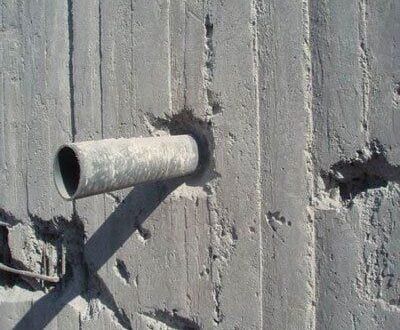
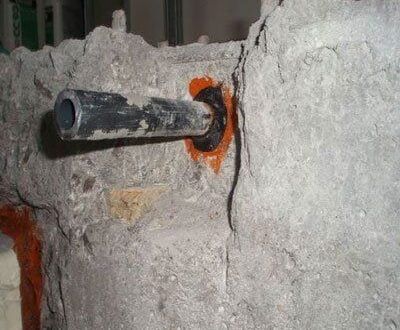
II. Waterproofing and repairing of existing pool failures with tiles or chipping in the topping surface.
A. In case there are failures in the topping surface of the existing pool, with tiles or chippings, cracks and water loss, the tiles or chippings should be removed and the cracks should be repaired with repairing mortar.
1A. Dismantling of tiles or chippings and checking of cementitious screed layer.
First, the tiles are stripped or the paint is removed and the smoothing cement mortar is checked for any failures. If the leveling cement mortar is healthy, the surface is cleaned of friable or polluting factors, which can negatively affect the adhesion of the repair materials and wetting of the substrate as water saturation. This is followed by the application of either PENETRON® MULTI PATCH general repair concrete repair mortar, or PENETRON® ACRYLIC PATCH polymer-modified early strength mortar, using PENETRON® ACRYLIC BONDCRETE acrylic adhesion improver to stabilize the substrate and increase adhesion , where this is deemed necessary. PENETRON® MULTI PATCH requires 3.1 kg to 3.4 kg of pure water per 25 kg of mortar and PENETRON® ACRYLIC PATCH requires 4.7 Lt to 5 Lt of pure water per 22.68 kg of mortar. For the repair of large cavities (larger than 50 mm fillings), we add to PENETRON® ACRYLIC PATCH, granular aggregate, up to 1 cm. The percentage of aggregates we add must not exceed 25% by weight of PENETRON® ACRYLIC PATCH. For repairs subject to hydrostatic pressure and active leaks, PENETRON® WATERPLUG RAPID fast setting conventional repair mortar is applied. Immediately after mixing in the proper proportion, as soon as PENETRON® WATERPLUG RAPID has a plastic texture or a "sandstone" texture, depending on the application, apply the material with force to the repair site, pressing it firmly by hand, trowel or another flat object. Press firmly for over a minute. In case of heavy water flow, press for about 6 minutes. Remove excess material with a knife or any sharp object. Do not use a trowel or brush. The final surface of the repairs is finished with suitable means, until a smooth surface is achieved.
2A. Waterproofing of the concrete surface with the conventional systems SEALCOATTM FLEX or SEALCOATTM ELASTIC
It is recommended to seal the surface of the cement mortar with SEALCOAT FLEX, an elastic or flexible, two-component adhesive sealant (flexible system by mixing 22.68 kg of PENETRON® SEALCOAT in solution with 4 kg of PENECRYL ELASTIC and 3 kg of water) or SEALCOAT ELASTIC (elastic system by mixing 22.68 kg PENETRON® SEALCOAT with 12 kg PENECRYL ELASTIC), depending on the requirements of the project, i.e. small and large requirements in bridging capillary cracks. Apply an aqueous coat of the required SEALCOAT™ FLEX or SEALCOAT™ ELASTIC evenly with a short-bristled brush. The next day, apply a second coat perpendicular to the first. The required consumption of the mixture SEALCOAT™ FLEX ~ 2kg/m2, for a total of 2 layers and SEALCOAT™ ELASTIC is ~ 2.5kg/m2, for a total of 2 layers. It is also possible to reinforce SEALCOAT™ SYSTEMS with glass mesh (5x5 mm frame). In this case, place the glass mesh on the fresh first layer and completely cover the mesh with the second layer, the next day. If required, apply a third coat of SEALCOAT™ FLEX or SEALCOAT™ ELASTIC. The addition of glass mesh may increase the consumption of the mixture to about 3 kg/m2 in total in all 3 layers.
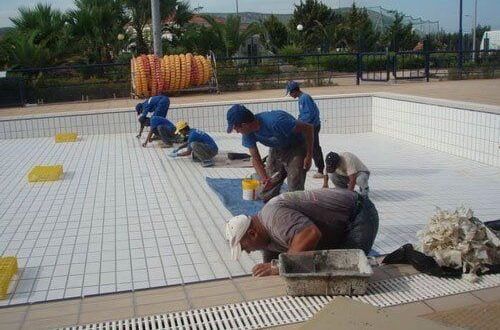
Usually if it is considered that the leveling cement mortar does not present problems or cracks, the SEALCOAT FLEX system is applied, for better adhesion of the glue to the surface or in special cases where it is necessary to bridge larger cracks on the surface of the mortar, the SEALCOAT ELASTIC system is applied. For gluing tiles over SEALCOAT SYSTEMS, a special FLEX adhesive for swimming pools is used.
B. In case there are failures in the topping surface of the existing pool, with tiles or chippings and there are cracks and water loss, the tiles or chippings should be removed, the cracks should be repaired with repairing mortar and the concrete should be repaired with crystalline waterproofing coating.
1B. Stripping the tiles and checking the leveling cement mortar (loose cement mortar).
First of all, the dismantling of tiles or chippings is required or the removal of colors and the checking of cementitious screed layer for failures. If the cementitious screed layer is not healthy, then the dismantling of cementitious screed layer is required, by a high-pressure jet waterblasting (300-500 bar).
Then, the water leaking cracks can be sealed with the rapid-setting crystalline waterproofing plug, PENEPLUG® (mix with minimum water, until the texture is as dry-earth). For a better application of PENEPLUG®, cracks should be routed out with mechanical means, up to 2 – 3 cm in width, in a conical shape, for better anchoring of the rapidsetting plug, during the application. Cold joints can be treated in a similar way, by cutting on both sides of the joint, with mechanical means and creating a wedge, 3 cm in width. At next, rapid-setting plug, PENEPLUG® is applied.
In some cases, depending on the work schedule, PENEPLUG® can be used as a waterplug, prior to waterblasting, but only after PENEPLUG® has reached its mechanical strength. It must be pointed out, that 1 – 2 layers of the integral crystalline waterproofing coating PENETRON®, at a mixing ratio of 5 parts PENETRON® powder to 3-3.5 parts water (by volume), must be applied on PENEPLUG®, by brush, while the latter is still “tacky” and the total consumption of PENETRON® mixture is 1.5 kg/m2 in total for 2 layers (depending on the surfaces, the indicative consumption should be between 1.1 to 1,6 kg / m2).
By mechanical means we widen the holes and nests that have resulted from concreting. Also, by mechanical means we widen the area around the "hairpins" to a width of at least 35 mm and a depth of 20-30 mm. Then we cut the "hairpin" with a wheel about 20 mm in. The "morels" are required to be completely removed or at least cut, creating a 30 x 30 x 40 mm reverse wedge recess. We rinse the holes with plenty of water, on the one hand to remove the generated solids, on the other hand to saturate the area with water, which is a necessary condition for the operation of the penetrating, penetrating, sealing material with chemical action and crystal growth PENETRON ® and the same technology repair PENECRETE MORTAR. On a surface that is wet and without pools of water, apply an aqueous mixture of PENETRON® sealing material, in a mixing ratio of 5 parts PENETRON® powder to 3.5 parts water (by volume), only in the area of the holes and nests and 1 cm around them . While the PENETRON® sealant is still fresh, mix PENECRETE MORTAR powder with enough water to achieve the desired plasticine texture [usual mixing ratio is 4.5 parts PENECRETE MORTAR with 1 part water (by volume)] and fill the holes and nests of the poor concrete. As soon as the repair mortar PENECRETE MORTAR has set, but is still wet, a second, only local, application with an aqueous mixture of PENETRON® follows.
2B. Application of Penetron® integral capillary waterproofing system.
It is possible to either apply PENETRON® water-based coating, penetrating, sealing material with chemical action and crystal development only to the inner surface of the pool, or to the outer surface as well (after excavating the surrounding surface). Alternatively, on the external surface it is possible to apply the SEALCOAT FLEX system (22.68 kg PENETRON® SEALCOAT in a solution with 4 kg PENECRYL ELASTIC and 3 kg water), reinforced with mesh or without, or the application of the elastomeric polyurethane membrane, two components, PENECOAT™ HYPER ELASTIC BLACK, by roller, brush or notched trowel, on the properly primed and prepared surface.
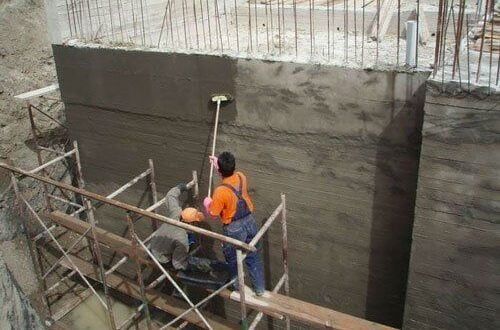
According to general directives for cement curing, PENETRON® SYSTEM should cure for 10-12 days, prior to water exposure.
3B. Neutralization
Because the application of PENETRON® products on the concrete surface causes the formation and appearance of silicates, not only inside the concrete, but most of the time also on the application surface (usually after the first 48 hours), you create a technical issue with the reduction the adhesion of decorative coatings or paints. The problem is dealt with by the process called "neutralization". Neutralization is essentially a "washing" of the surface after about 3 weeks (safe time of PENETRON® system operation) with a low "aggressive" acid, such as a 3-8% hydrochloric acid (HCl) solution or a vinegar solution with water (in a ratio of 1:1 to 1:3, depending on acidity). Penetron
During application, after cleaning the surface with a broom, using a brush and a plastic container containing the neutralization liquid, we "wash" the surface and then, after a few minutes, rinse with plenty of clean water. The surface can then, after drying, be plastered or painted. Alternatively, in the case of coatings or coating mortars, it can be applied within 48 hours and before the appearance of silicates on the surface. Penetron
In this case, the time for overlay is minimized, however, the inability to control the correct application and operation of the system remains a disadvantage. Also, in this case, there is always a small chance that some percentage of crystals will penetrate the mortars or plasters and appear slightly on their surface. Penetron
4B. Application of a bonding layer and roughcasting / cementitious mortar to cover the concrete elements and smooth the walls and the bottom of the pool.
Initially, an adhesion layer is applied on the concrete elements for the application of the main cement mortar. The adhesion layer includes either the application of the acrylic resin PENETRON® ACRYLIC BONDCRETE or PRIMER STX 100, depending on the conditions of the substrate, undiluted with an indicative consumption of 4.9 Lt/m2, or the application of adhesion material, "cast", which consists of of 1 part cement with 2-3 parts sand (by volume) mixed in an aqueous solution of 1 part PENETRON® LATEX acrylic resin with two parts water (by volume). Penetron
Then the "guides" are made for the application of the filler or mortar. The "drivers" and "fill" consist of 1 part cement and 3 parts sand mixed in a solution of 1 part PENETRON® LATEX building resin with two to three parts water (by volume), to which polypropylene fibers are also added to prevent cracking . The cement content of the leveling mortar and "guides" is 400-500 kg/m3. Also, PENETRON ADMIX® is added in a proportion of 0.8 – 1% by weight of cement. Penetron
NOTE: In all previous applications lime is never used.Penetron
5B. Finishing cementitious screed layer (fine or grater).
It is recommended to seal the surface of the cement mortar with SEALCOAT FLEX, an elastic or flexible, two-component adhesive sealant (flexible system by mixing 22.68 kg of PENETRON® SEALCOAT in solution with 4 kg of PENECRYL ELASTIC and 3 kg of water) or SEALCOAT ELASTIC (elastic system by mixing 22.68 kg PENETRON® SEALCOAT with 12 kg PENECRYL ELASTIC), depending on the requirements of the project, i.e. small and large requirements in bridging capillary cracks. Apply an aqueous coat of the required SEALCOAT™ FLEX or SEALCOAT™ ELASTIC evenly with a short-bristled brush. Penetron.
The next day, apply a second coat perpendicular to the first. The required consumption of the mixture SEALCOAT™ FLEX ~ 2kg/m2, for a total of 2 layers and SEALCOAT™ ELASTIC is ~ 2.5kg/m2, for a total of 2 layers. It is also possible to reinforce SEALCOAT™ SYSTEMS with glass mesh (5x5 mm frame). In this case, place the glass mesh on the fresh first layer and completely cover the mesh with the second layer, the next day. If required, apply a third coat of SEALCOAT™ FLEX or SEALCOAT™ ELASTIC. The addition of glass mesh may increase the consumption of the mixture to about 3 kg/m2 in total in all 3 layers. Penetron
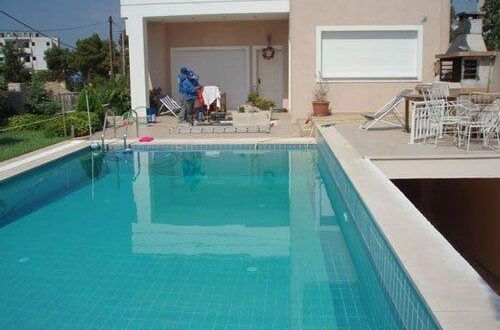
Usually, if it is considered that the smoothing cement mortar does not present problems or cracks, the SEALCOAT FLEX system is applied, for better adhesion of the adhesive to the surface or in special cases where it is necessary to bridge larger cracks on the surface of the mortar, it is applied
Installation of matching PENEBAR SW hydro-inflatable cord on pool pipes and fittings.
In the case of retrofitting components or pipes that require perimeter sealing/sealing, the corresponding perimeter installation of PENEBAR SW water-inflatable cords is recommended (recommended type of controlled expansion PENEBAR SW 55 TYPE B or often half of type 55 B). The material is placed at a depth of at least 5 cm and covered with fast-setting hydraulic mortar with PENEPLUG® crystal growth.
NOTE: The perimeter cavity for placing the hydro-expandable cord that will then be filled with PENEPLUG® should be in the form of an inverted wedge, for better anchoring of the mortar.
III. Waterproofing and repairing of existing pool failures, with color in the topping surface.
A. In case there are failures in the topping surface of the existing pool with tiles or chippings and there are cracks and water loss, the tiles or chippings should be removed and the cracks should be repaired, with repairing mortar.
1A.Color removal and checking of cementitious screed layer.
First, the paint is removed and the smoothing cement mortar is checked for any failures. If the leveling cement mortar is healthy, the surface is cleaned of friable or polluting factors, which can negatively affect the adhesion of the repair materials and wetting of the substrate as water saturation. This is followed by the application of either PENETRON® MULTI PATCH general repair concrete repair mortar, or PENETRON® ACRYLIC PATCH polymer-modified early strength mortar, using PENETRON® ACRYLIC BONDCRETE acrylic adhesion improver to stabilize the substrate and increase adhesion , where this is deemed necessary. PENETRON® MULTI PATCH requires 3.1 kg to 3.4 kg of pure water per 25 kg of mortar and PENETRON® ACRYLIC PATCH requires 4.7 Lt to 5 Lt of pure water per 22.68 kg of mortar. For the repair of large cavities (larger than 50 mm fillings), we add to PENETRON® ACRYLIC PATCH, granular aggregate, up to 1 cm. The percentage of aggregates we add must not exceed 25% by weight of PENETRON® ACRYLIC PATCH. For repairs subject to hydrostatic pressure and active leaks, PENETRON® WATERPLUG RAPID fast setting conventional repair mortar is applied. Immediately after mixing in the proper ratio, as soon as PENETRON® WATERPLUG RAPID has a plastic texture or a "sandstone" texture, depending on the application, apply the material with force to the repair site, pressing it firmly by hand, trowel or another flat object. Press firmly for over a minute. In case of heavy water flow, press for about 6 minutes. Remove excess material with a knife or any sharp object. Do not use a trowel or brush. The final surface of the repairs is finished with suitable means, until a smooth surface is achieved.
2A. Waterproofing of the concrete surface with the conventional systems SEALCOATTM FLEX or SEALCOATTM ELASTIC.
After the smoothing layer with cement mortar ("slurry"), there is usually a thin layer of mortar with fine aggregates and a very good finish. Especially in cases where pool paint follows (PENECOAT POOL).
This thin finish layer can be produced with conventional materials such as fine sand and quartz aggregates and high cement content (>400 kg/m3). It is also possible to apply, alternatively, a finished product with fine quartz aggregates, PENETRON® TOP FINISH FINE, with an indicative consumption of 1.6 kg/m2 per mm of thickness, usually in a gray or white shade. It is recommended to use an adhesion primer (PENETRON® ACRYLIC BONDCRETE). Finally, PENECOAT POOL polyurethane pool paint is used in the desired color, with an indicative consumption of 0.15 to 0.20 kgr/m2 per layer. It is applied in two or three layers.
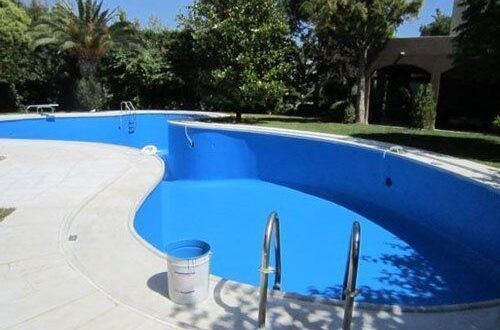
B. In case there are failures in the topping surface of the existing pool, with tiles or chippings and there are cracks and water loss, the tiles or chippings should be removed, the cracks should be repaired with repairing mortar and the concrete should be repaired with crystalline waterproofing coating.
1B. Removal of paint and control of leveling cement mortar (loose cement mortar).
First of all, remove colors and check of cementitious screed layer for failures. If the cementitious screed layer is not healthy, then the dismantling of cementitious screed layer is required, by a high-pressure jet waterblasting (300- 500 bar). Depending on the working procedures, concrete surface can be treated and cleaned by a high-pressure jet waterblasting (300-500 bar), for better visual contact with faulty areas.
Then, the water leaking cracks can be sealed with the rapid-setting crystalline waterproofing plug, PENEPLUG® (mix with minimum water, until the texture is as dry-earth). For a better application of PENEPLUG®, cracks should be routed out with mechanical means, up to 2 – 3 cm in width, in a conical shape, for better anchoring of the rapidsetting plug, during the application. Cold joints can be treated in a similar way, by cutting on both sides of the joint, with mechanical means and creating a wedge, 3 cm in width. At next, rapid-setting plug, PENEPLUG® is applied.
In some cases, depending on the design of the works, we can apply PENEPLUG® first, so as to limit the inflow of water and then the treatment with water jetting, since PENEPLUG® has acquired good mechanical resistance. It should be clarified, that the PENEPLUG®, after it has been drawn (still fresh), should be applied 1 – 2 layers of PENETRON® aqueous chemical action and crystal growth mixture, in a mixing ratio of 5 parts PENETRON® powder to 3 – 3.5 parts water (by volume), for easy application with a brush, and consumption in total for both 2 layers, approximately, 1.5 kg/m2.
By mechanical means we widen the holes and nests that have resulted from concreting. Also, by mechanical means we widen the area around the "hairpins" to a width of at least 35 mm and a depth of 20-30 mm. Then we cut the "hairpin" with a wheel about 20 mm in. The "morels" are required to be completely removed or at least cut, creating a 30 x 30 x 40mm reverse wedge recess. We rinse the holes with plenty of water, on the one hand to remove the generated solids, on the other hand to saturate the area with water, which is also a necessary condition for the operation of the penetrating, penetrating, waterproofing material with chemical action and crystal growth PENETRON® and the repair of the same technology as PENECRETE MORTAR. On a surface that is wet and without pools of water, apply an aqueous mixture of PENETRON® sealing material, in a mixing ratio of 5 parts PENETRON® powder to 3.5 parts water (by volume), only in the area of the holes and nests and 1 cm around them . While the PENETRON® sealant is still fresh, mix PENECRETE MORTAR powder with enough water to achieve the desired plasticine texture [usual mixing ratio is 4.5 parts PENECRETE MORTAR with 1 part water (by volume)] and fill the holes and nests of the poor concrete. As soon as the repair mortar PENECRETE MORTAR has set, but is still wet, a second, only local, application with an aqueous mixture of PENETRON® follows.
2B. Application of Penetron® integral capillary waterproofing system.
It is possible to either apply PENETRON® water-based coating, penetrating, sealing material with chemical action and crystal development only to the inner surface of the pool, or to the outer surface as well (after excavating the surrounding surface). Alternatively, on the external surface it is possible to apply the SEALCOAT FLEX system (22.68 kg PENETRON® SEALCOAT in a solution with 4 kg PENECRYL ELASTIC and 3 kg water), reinforced with mesh or without, or the application of the elastomeric polyurethane membrane, two components, PENECOAT™ HYPER ELASTIC BLACK, by roller, brush or notched trowel, on the properly primed and prepared surface.
This is followed by soaking for 1 – 2 days to activate the PENETRON® crystal growth system and then a 12 day wait for the system to fully activate. Then, the pool is filled with cold clean water (for 3-4 days) and emptied, for the complete cleaning and control of the pool. Penetron
3B. Neutralization
Because the application of PENETRON® products on the concrete surface causes the formation and appearance of silicates, not only inside the concrete, but most of the time also on the application surface (usually after the first 48 hours), you create a technical issue with the reduction the adhesion of decorative coatings or paints. The problem is dealt with by the process called "neutralization". Neutralization is essentially a "washing" of the surface after about 3 weeks (safe time of PENETRON® system operation) with a low "aggressive" acid, such as a 3-8% hydrochloric acid (HCl) solution or a vinegar solution with water (in a ratio of 1:1 to 1:3, depending on acidity). Penetron
During the application, after the surface is cleaned with a vacuum cleaner, use a brush and a plastic pail, containing the solution for the neutralization, “wash” the surface with the solution and after a few minutes, wash the surface with excess water. Then, the surface, can be coated or painted, after it is dry. Alternatively, for the use of decorative screeds, they can be applied within the first 48 hours and before the formation of the silicic acids on the surface. In that case, the time for the coating application is minimized, but the drawback is the inability to control the correct application and operation of the system. Also, in that case, there is always a small possibility for a percent of the formed crystals to penetrate the coatings or screeds and appear on the surface.
4B. Application of a bonding layer and roughcasting / cementitious mortar to cover the concrete elements and smooth the walls and the bottom of the pool.
Initially, an adhesion layer is applied on the concrete elements for the application of the main cement mortar. The adhesion layer includes either the application of the acrylic resin PENETRON® ACRYLIC BONDCRETE or PRIMER STX 100, depending on the conditions of the substrate, undiluted with an indicative consumption of 4.9 Lt/m2, or the application of adhesion material, "cast", which consists of of 1 part cement with 2-3 parts sand (by volume) mixed in an aqueous solution of 1 part PENETRON® LATEX acrylic resin with two parts water (by volume).
Then the "guides" are made for the application of the filler or mortar. The "drivers" and "fill" consist of 1 part cement and 3 parts sand mixed in a solution of 1 part PENETRON® LATEX building resin with two to three parts water (by volume), to which polypropylene fibers are also added to prevent cracking . The cement content of the leveling mortar and "guides" is 400-500 kg/m3. Also, PENETRON ADMIX® is added in a proportion of 0.8 – 1% by weight of cement.
NOTE: In all previous applications lime is never used.
5B. Finishing cementitious screed layer (fine or grater).
After the smoothing layer with cement mortar ("slurry"), there is usually a thin layer of mortar with fine aggregates and a very good finish. Especially in cases where pool paint follows (PENECOAT POOL).
This thin finish layer can be produced with conventional materials such as fine sand and quartz aggregates and high cement content (>400 kg/m3). It is also possible to apply, alternatively, a finished product with fine quartz aggregates, PENETRON® TOP FINISH FINE, with an indicative consumption of 1.6 kg/m2 per mm of thickness, usually in a gray or white shade. It is recommended to use an adhesion primer (PENETRON® ACRYLIC BONDCRETE). Finally, PENECOAT POOL polyurethane pool paint is used in the desired color, with an indicative consumption of 0.15 to 0.20 kgr/m2 per layer. It is applied in two or three layers.
C. In the case of an existing swimming pool with shaped end surfaces, with swimming pool paint, where a failure of the paint has been observed, without the creation of failures in the construction, then the repainting of the pool with PENECOAT POOL polyurethane paint is considered.
First, the paint color is rubbed well until it is well polished. Any loose or friable parts or dirt that can adversely affect the adhesion of the new paint must be removed. Old paint coatings must be removed and the surface roughened for better paint adhesion. In the event of cracks appearing on the surface of the cement mortar, either PENETRON® MULTI PATCH repair mortar for general concrete repairs, or PENETRON® ACRYLIC PATCH, an early strength development mortar with modified polymers, is applied, with the use of PENETRON® ACRYLIC BONDCRETE acrylic adhesion improver to stabilize it substrate and increasing adhesion, where this is deemed necessary. PENETRON® MULTI PATCH requires 3.1 kg to 3.4 kg of pure water per 25 kg of mortar and PENETRON® ACRYLIC PATCH requires 4.7 Lt to 5 Lt of pure water per 22.68 kg of mortar. For the repair of large cavities (larger than 50 mm fillings), we add to PENETRON® ACRYLIC PATCH, granular aggregate, up to 1 cm. The percentage of aggregates we add must not exceed 25% by weight of PENETRON® ACRYLIC PATCH.
Finally, and as long as the surface humidity is less than 5%, PENECOAT POOL polyurethane pool paint is applied in the desired color, with an indicative consumption of 0.15 to 0.20 kgr/m2 per layer. It is applied in two or three layers.
Installation of matching PENEBAR SW hydro-inflatable cord on pool pipes and fittings.
In the case of retrofitting components or pipes that require perimeter sealing/sealing, the corresponding perimeter installation of PENEBAR SW water-inflatable cords is recommended (recommended type of controlled expansion PENEBAR SW 55 TYPE B or often half of type 55 B). The material is placed at a depth of at least 5 cm and covered with fast-setting hydraulic mortar with PENEPLUG® crystal growth.
NOTE: The perimeter cavity for placing the hydro-expandable cord that will then be filled with PENEPLUG® should be in the form of an inverted wedge, for better anchoring of the mortar. Penetron
Following is a schematic illustration of discontinuity repairs with PENETRON® chemical action and crystal growth materials from PENETRON INTERNATIONAL LTD. Penetron
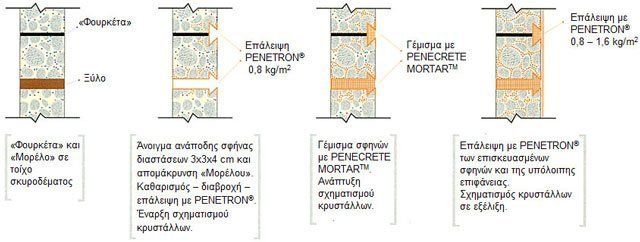
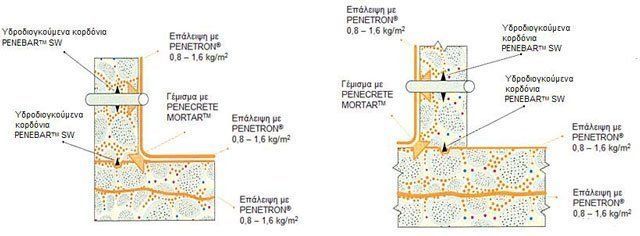
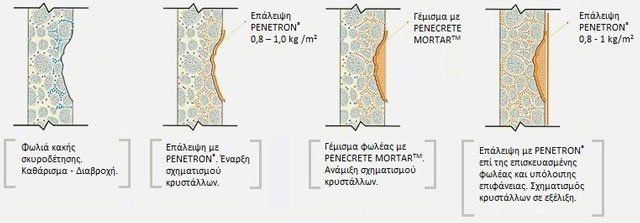
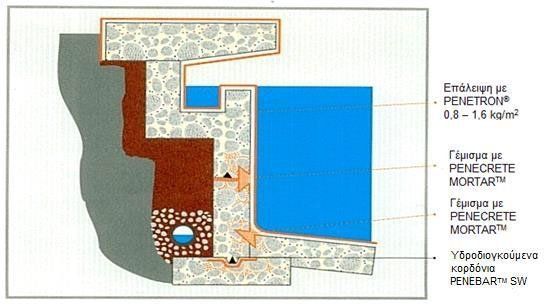
To clarify that the above is not a construction study, but a technical proposal according to the information we have for the corresponding project and based on our best experience and knowledge so far. For more information regarding the safe use, processing and storage of the products contact PENETRON HELLAS, at Product Characteristics Sheet and to Product Safe Use Leaflet for every product you use. Penetron
PENETRON HELLAS
THRAKOMACEDONON 52A
136 71 ACHARNES
TEL: 210 2448250 – FAX: 210 2476803
www.penetron.gr – info@penetron.gr



No Comments